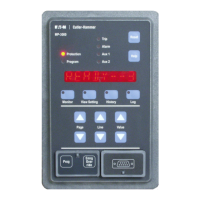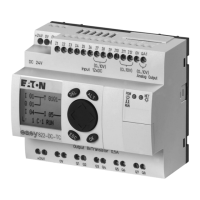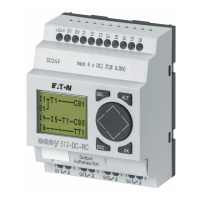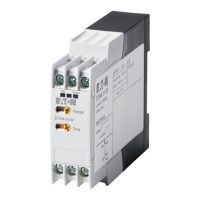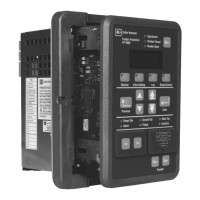Page 9-4
www.eaton.com
IB02602002E MP-4000
The thermal algorithm incorporates the accentuated heating effect
of negative sequence currents or these certain harmonics, and trips
more rapidly for unbalanced conditions than would be expected from
the cold-start balanced protection curve.
In addition to the thermal algorithm, the MP-4000 includes a percent
unbalance function that alarms and/or trips based on direct measure-
ment of unbalance. This can be used to speed up tripping and avoid
motor heating for a gross problem, such as depressed voltage on one
phase, loss of a phase, or an uncleared power-system fault external to
the protected motor.
The unbalance is the ratio of negative sequence to positive sequence
current. If the motor can be started in either direction (P1L8 = REV),
the MP-4000 takes the larger of the two sequence currents at the time
of the start as the positive sequence current.
The sequence currents are accurately calculated according to the de-
nition, which relates directly to heating. Note that signicant negative
sequence current is present if the phase angles are not symmetrical,
even though the three-phase current magnitudes are equal.
The unbalance trip and alarm functions can each be set from 4% to
40%, or OFF. A common start delay is provided (UBSD, P3L13), plus
separate trip (UBTR, P3L14) and alarm (UBAR, P4L8) run delays.
Use the run delays to ride through external-system unbalanced faults,
which could last for several seconds. Check the time curve settings
of feeder relays or fuses. Keep in mind that high-resistance or arcing
faults, which may take a longer time to clear, have less tendency to
severely depress voltage than a solid fault.
9.1.10 Ground Fault Protection Application
Use this fault-protection function with a ux-canceling ground fault CT.
This CT has a large primary window through which all three-phase
conductors can pass. The most common ground fault CTs have a
ratio of 50:5 or 50:1.
The MP-4000 is recognized to UL 1053, Ground Fault Protective
Device standard. This may eliminate the need for a separate ground
fault protector in many applications that formerly required it.
Note that the ground fault trip and alarm current settings GFT, P3L1
and GFA, P4L1 are based on percentage of ground CT rated primary
current, not on FLA or the phase CT ratio. For example, setting 10%
gives a trip or alarm for an actual ground leakage current of 5 A with a
50:5 CT (GCT, P1L6 = 50).
This function is only useful for a grounded power system. The ground
return is normally made from the neutral of the secondary wire winding
of the supply power transformer. Resistance grounding is acceptable,
as long as the resulting fault current is at a level the relay can be set
to detect.
The ground CT, which provides sensitive protection for high-resistance
ground faults, may saturate for a robust heavy-current ground fault
in a solidly-grounded system. Minimize the saturation problem by
minimizing the burden. Use the shortest and heaviest leads possible
between the ground CT and the relay. The MP-4000 itself has very
low burden, usually much lower than the connecting wiring. Calcu-
late the current magnitude which saturates the ground CT. Consider
the CT secondary voltage capability and the total burden of the CT
secondary winding itself, the connecting wires, and the relay. Make
sure this saturation current is well above the minimum sensitivity of the
phase IOC function and/or the motor fuses.
A residual connection – the wired summation of the phase CT circuits
through the ground CT input – requires a much higher GFT setting to
avoid false tripping. Thus, sensitivity is not nearly as good as with a
separate ux-canceling CT. If the MP-4000 relay is installed where
a residual connection is used, GCT should be set to the same value
as PCT. The User must then set the ground fault trip level at a high
value to avoid nuisance tripping from CT ratio errors, third harmonic
and certain higher harmonics, or other measurement errors producing
false residual currents. Monitor the metered ground current during
various loading conditions to ensure a good margin between these er-
ror currents and the ground fault trip current setting GFT, P3L1. Also,
watch out for phase CTs that saturate during motor starting. The satu-
ration produces a large residual current and a ground fault trip. This
may be a problem if the CTs have a low voltage capability (e.g.: C5 or
C10), have long wiring runs, or are otherwise heavily burdened.
9.1.11 Voltage Functions
Voltage functions are triggered if the measured voltage exceeds the
over voltage threshold setting or drops below the under voltage setting
for a period of time exceeding the associated run delay setting.
9.1.12 Frequency Functions
Frequency functions are triggered if the measured frequency exceeds
the over frequency setting or drops below the under frequency setting
for a period of time exceeding the associated run delay setting.
9.1.13 Power Factor Functions
Power factor functions are triggered if the measured power factor
exceeds the leading or lagging power factor setting.
9.2 Motor Cycle Monitoring
This refers to the MP-4000 functions that monitor the motor during pe-
riods of normal operation. Normal operation includes the start cycle,
run cycle, and stop cycle. Trips may occur at any time. The MP-4000
time tags many critical changes of state, and stores them with support-
ing data in log books and history records.
The primary function of the MP-4000 is to alarm, as well as to trip
and block, the motor contactor for faults and abnormal or dangerous
operating conditions. It can also exercise some active control of a
normally functioning motor and/or its load. Active control functions
include transition control to full running voltage for a reduced-voltage
starter as explained in Subsection 9.2.1. Process load shedding that
reduces overload is covered in Subsection 9.1.5. Other functions can
be programmed by assigning a particular internal MP-4000 measure-
ment to a contact output with output relay settings.
9.2.1 Start Cycle and Transition Tripping
Figure 9.6 shows an example of how the MP-4000 reacts to a normal
operating-cycle current prole. Initially, the motor is stopped and the
current is zero. As long as the MP-4000 is not in a trip state, it permits
contactor energization by closing its trip contact in series with the con-
tactor. The contactor is energized by the operator or process control
system through a normal two-wire or three-wire motor control scheme,
external to the MP-4000. The MP-4000 declares a motor start when
it senses a motor current that exceeds 305 of the FLA setting (P1L1).
The message START is displayed and the transition timer (TRNT,
P5L6) begins to run. Also, the MP-4000 monitors the large starting
current, noting when the current falls below the transition level TRNC,
P5L5.
Using the TRN XXX setting P5L7, the User can select one of four
transition behaviors:
TRN TIME - Transition to RUN after time setting (P5L6) only. Current
is ignored.
TRN I - Transition when starting current drops below setting (P5L5)
only. If the time set in TRNT P5L6 expires before the current transi-
tion, the motor trips.
TRN T+C - Transition on time or current, whichever comes rst.
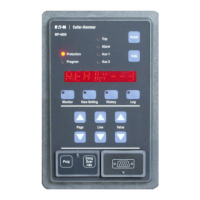
